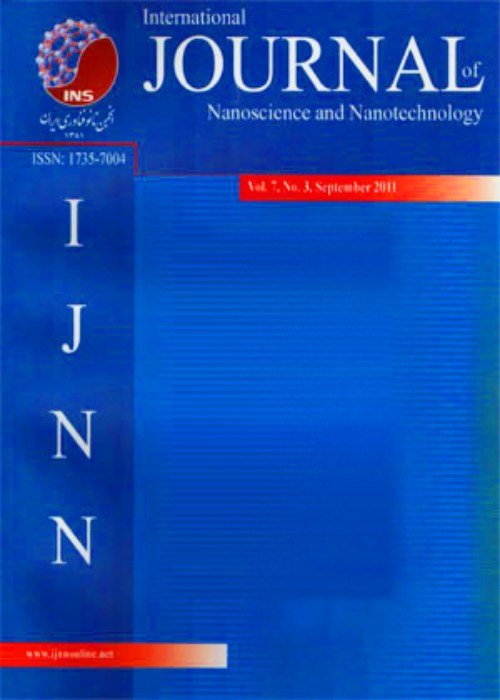فهرست مطالب
International Journal Of Nanoscience and Nanotechnology
Volume:7 Issue: 4, Autumn 2011
- تاریخ انتشار: 1390/09/28
- تعداد عناوین: 7
-
-
Pages 161-166Within the effective-field theory with correlations (EFT), a transverse random field spin-1 Ising model on the simple cubic (z=6) lattice is studied. The phase diagrams, the behavior of critical points, transverse magnetization, internal energy, magnetic specific heat are obtained numerically and discussed for different values of p the concentration of the random transverse field.Keywords: Transverse Ising model, Effective, field theory, Phase transition, Magnetic properties
-
Pages 167-172Ruthenium dioxide nanoparticles (RuO2) with an average particle size of 50 nm are readily synthesized from RuCl3.xH2O via the precipitation process in the presence of in-situ sodium octanoate as anionic surfactant. The phase composition, morphology, lattice parameters and size of nanoparticles in these products are characterized by Fourier transform infrared spectroscopy (FT-IR), X-ray diffraction (XRD), scanning electron microscopy (SEM).Keywords: Ruthenium dioxide, Nanoparticles, Co, precipitation, X-ray diffraction, SEM, Octanoic acid
-
Pages 173-182In this work, a molecular dynamics simulation of the transport of water - methanol mixture through the single wall carbon nanotube (SWCNT) is reported. Methanol and water are selected as fluid molecules since water represents a strongly polar molecule while methanol is as an intermediate between polar and strongly polar molecules. Some physical properties of the methanol-water mixture such as radial and axial density, hydrogen bonding, number of contacts and minimum distance between mixture and SWCNT molecules and also diffusivity of the mixture as a transport property were calculated during the simulation. Results showed that mixture of the selected molecules inside SWCNT have different properties during transport along the SWCNT in comparison with pure fluids inside SWCNT. Also methanol molecules diffuse faster than water molecules inside nanotube due to a weaker hydrogen bonding network. These differences among physical properties of the fluids inside SWCNT can be a key parameter for designing the new separation equipments and sensors using SWCNT.Keywords: Molecular dynamics simulation, Diffusion, Hydrogen bond, minimum distance
-
Pages 183-189In this paper, we have studied the electrical properties of the randomly distributed metallic (Co and Fe) nano/ micro wires on Silicon substrate. Deposition was carried out potentiostatically into the pores of the track-etch polycarbonate membrane spin coated onto the Si substrate. Spin coated films were irradiated with 150MeV Ni (+11) ions at a fluence of 8E7 ions/cm2, followed by UV irradiation and chemically etching in aqueous NaOH (6N, at room temperature). The size, shape and morphology of the synthesized nano/micro structures is strongly dependent on the preparation conditions such as deposition potential, current density, electrolyte and etching conditions. Later, morphological and electrical properties of the so deposited nano-/micro structureswere studied.Keywords: Irradiation, Ion track, etching
-
Pages 190-196In this paper, based on the coupled-mode and carrier rate equations, a dynamic model and numerical analysis of a multi quantum well (MQW) chirped distributed feedback semiconductor optical amplifier (DFB-SOA) all-optical flip-flop is precisely derived. We have analyzed the effects of strains of QW and MQW and cross phase modulation (XPM) on the dynamic response, and rise and fall times of the DFB-SOA all optical flip flop. We have shown that strained MQW active region under an optimized condition into a DFB-SOA with chirped grating can improve the switching ON speed limitation in the abovementioned device, significantly while the fall time is increased. The values of the rise times for such an all optical flip-flop, are obtained in an optimized condition, areas tr=255ps.Keywords: All, Optical Flip, Flop, Distributed feedback semiconductor optical amplifier, Optical Bistability
-
Pages 197-200In this study, magnetic iron oxide nanoparticles (Fe3O4) with the size range of 20-30 nm were prepared by the modified controlled chemical co-precipitation method from the solution of ferrous/ferric mixed salt-solution in alkaline medium. In this process polyethylene glycol was used as a surfactant to prevent the solution from agglomeration. The prepared magnetic nanoparticles were characterized by X-ray diffraction (XRD) analysis, scanning electron microscopy (SEM) and vibrating-sample magnetometer (VSM). XRD image indicates the sole existence of inverse cubic spinel phase of magnetic iron oxide nanoparticles (Fe3O4). SEM image show that the dimension of magnetic iron oxide nanoparticles (Fe3O4) is about 24 nm. VSM patterns demonstrate superparamagnetic properties of magnetic nanoparticles.
-
Pages 201-204In this study, Polyaniline molecule (emeraldine base) is modeled as a molecular wire and the effects of the metal/molecule coupling strength and the molecule length on the current-voltage (I-V) characteristics are numerically investigated. Using a tight-binding Hamiltonian model, the methods based on Non-equilibrium Green’s function theory, Landauer formalism and Newns-Anderson model, our calculations indicate that the I-V curve has the step-like form and the current is very sensitive to the metal/molecule coupling strength. A negative differential resistance region is also exhibited after second voltage step in the I-V curves and the line slope at that region is studied as a function of two parameters, which are the metal/molecule coupling strength and the molecule length.Keywords: Molecular wire, Polyaniline (emeraldine base), Landauer formalism, I, V characteristics


